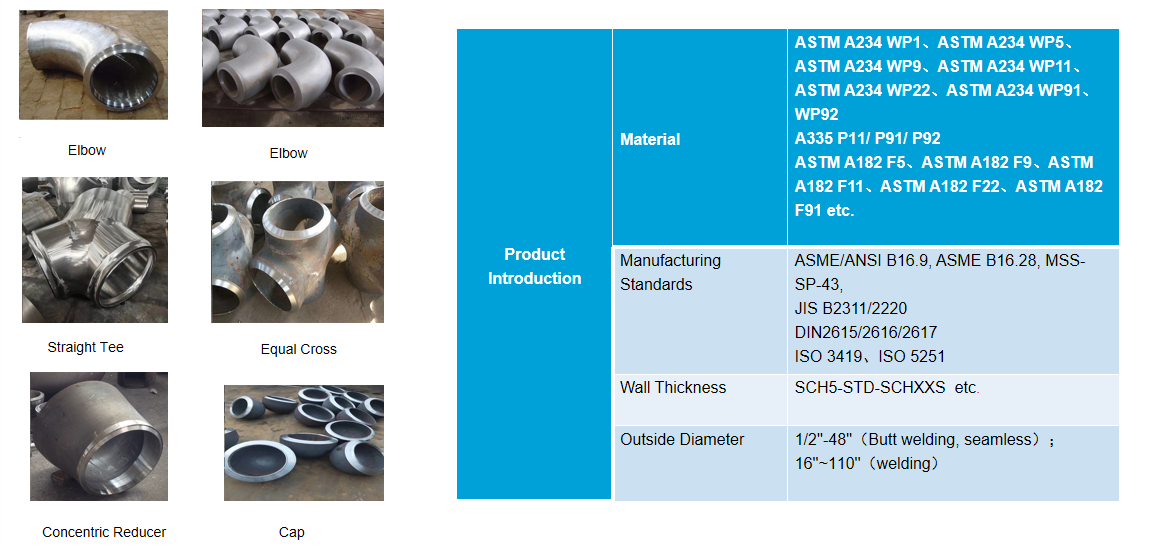Beijing Hownew Energy Technology Group Co., Ltd |
|
Verified Suppliers
|
|
Alloy steel pipes and fittings are highly prized in critical industries due to their exceptional properties. Below are some key characteristics and benefits that alloy steel elbows bring to various applications:
Key Characteristics of Alloy Steel Pipe Fittings:
High Pressure Resistance:
Alloy steel fittings are robust and can handle extreme pressure,
making them ideal for high-pressure applications such as hydraulic
systems, steam lines, and in oil and gas pipelines. Their ability
to withstand high pressure ensures the reliability and safety of
the entire piping system.
Outstanding Corrosion Resistance:
These fittings exhibit excellent resistance to both oxidative and
reductive environments, which makes them suitable for handling a
wide range of chemicals and conditions. This resistance to
corrosion helps in extending the life of the pipeline systems and
minimizes the need for frequent maintenance or replacement, thereby
reducing overall operational costs.
Durability in Varied Media:
The ability to resist corrosion from both acidic and alkaline media
makes alloy steel pipe fittings exceptionally durable. This
property is crucial for industries such as chemical processing
where exposure to harsh chemicals is common.
Dimensional Stability:
Alloy steel maintains its form and dimension under harsh
conditions, including varying temperatures and pressures. This
stability ensures a reliable fit and continuous operation, reducing
the likelihood of leaks and maintaining system integrity.
Ease of Installation:
Despite their strength and durability, alloy steel fittings are
designed to be easy to install. This ease of installation helps in
speeding up project timelines and reduces labor costs. Moreover,
the versatility of these fittings means they can be adapted to a
variety of configurations and sizes, accommodating the specific
needs of different piping systems.
Applications:
Given these characteristics, alloy steel pipe fittings are
extensively used in sectors such as:
Petroleum and Gas Industry: For transporting oils, gases, and other
fluids where pressure and chemical resistance are mandatory.
Chemical Processing: In handling various chemical productions where
acidic and alkaline media are present.
Power Generation: In steam, water, and gas turbines where high
temperature and pressure conditions exist.
Shipbuilding and Marine: In environments where resistance to
saltwater corrosion is necessary.
Conclusion:
Alloy steel pipe fittings, particularly elbows, offer enhanced
performance in demanding environments, ensuring system safety,
longevity, and efficiency. Their use in industries that handle
extreme conditions demonstrates their capability to meet high
standards of quality and reliability, making them an indispensable
part of modern industrial operations.
The manufacturing process of alloy steel pipe fittings is meticulously designed to produce components that can withstand harsh environments and mechanical stresses. Below is a detailed overview of the key stages involved in the manufacturing of these critical pipeline components:
Manufacturing Process of Alloy Steel Pipe Fittings:
Material Preparation:
Selection of Raw Material: The process begins with selecting the
appropriate grade of alloy steel that meets the specific
requirements for strength, corrosion resistance, and ductility.
This raw material usually comes in the form of billets or rods.
Cutting: The selected material is cut to the required size,
typically using sawing or shearing methods, to prepare for the
forming processes.
Forming:
Forging: This involves heating the cut pieces of alloy steel to
high temperatures and then deforming them under high pressure to
form the desired shapes. Forging is preferred for making fittings
because it enhances the metallurgical properties by refining the
grain structure of the steel, improving its strength and resistance
to impact and fatigue.
Cold Stamping: For less complex shapes or thinner materials, cold
stamping may be used. This process involves shaping the steel at
room temperature, offering a quick and cost-effective method for
simpler designs.
Heat Treatment:
Normalizing or Quenching and Tempering: After forming, the fittings
undergo heat treatment to achieve the desired mechanical
properties. Normalizing involves heating the steel above its
recrystallization temperature and then allowing it to cool in air.
This process refines the grain structure, improving toughness and
making the steel easier to machine.
Quenching and Tempering: This is a two-step process where the steel
is first heated to a high temperature and then rapidly cooled
(quenched) in water or oil. This hardens the steel. Tempering
follows, where the steel is reheated to a lower temperature and
then cooled, which reduces brittleness while maintaining hardness.
Finishing:
Machining: The rough fittings might require machining to achieve
precise dimensions and surface finish.
Surface Treatment: Surface treatments such as coating or
galvanizing are applied to improve corrosion resistance, especially
if the fittings are to be used in aggressive environments.
Inspection and Testing:
Various tests are conducted throughout and after the manufacturing
process to ensure that the fittings meet all required
specifications and quality standards. These tests may include
dimensional checks, mechanical testing, and non-destructive testing
(NDT) such as X-ray or ultrasonic tests.
Working Principle:
Alloy steel pipe fittings, such as elbows, tees, and reducers, are
used to change the direction of flow in a piping system, connect
different sized pipes, or join pipes together. The integrity and
reliability of these fittings are crucial for maintaining the safe
operation of pipeline systems, particularly in industries where
high pressures and corrosive materials are common.
By understanding the comprehensive manufacturing process and the working principle of alloy steel pipe fittings, engineers and project managers can better select and utilize these components for their specific industrial needs.


Our company can produce carbon steel, stainless steel, and alloy steel pipe fittings according to standards such as ASME/ANSI, JIS, DIN, ISO etc. The varieties include equal diameter tees, reducing tees, tees, elbows, cross, concentric reducer, eccentric reducer etc. We provide the very best quality pipe and fittings, prompt delivery and reliable services at competitive prices.